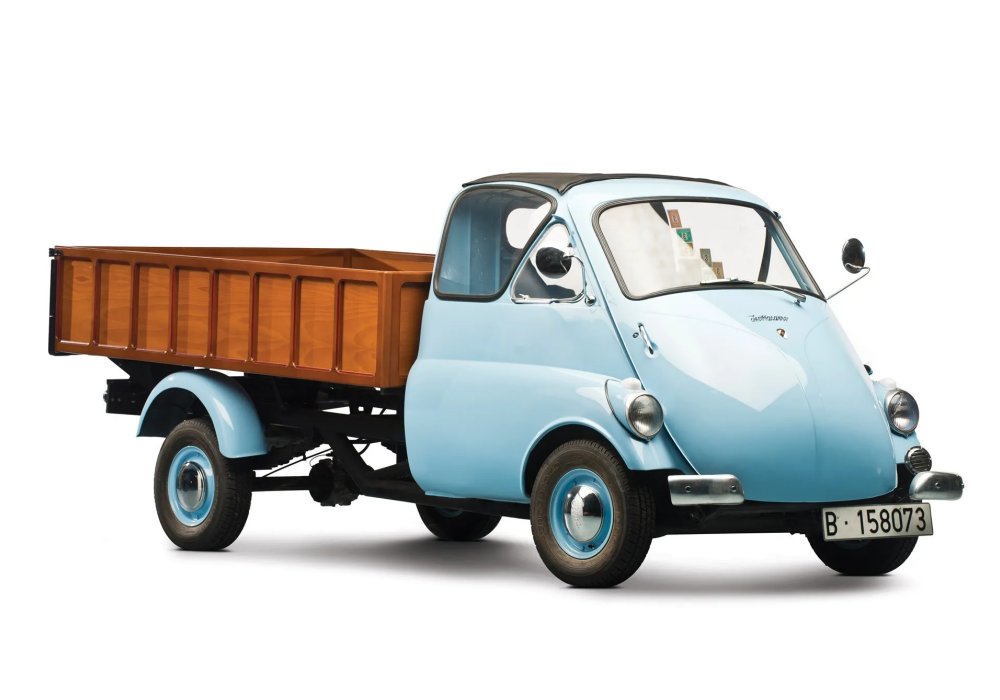Description
The ISO Autocarro was a sturdy and practical light commercial vehicle produced by ISO Rivolta of Milan during the early 1950s—a period when Italy was rebuilding its economy and the demand for affordable, versatile transport was immense. While ISO would later become world-famous for the tiny Isetta and its luxurious GT cars like the Rivolta and Grifo, the Autocarro represented a different side of the company’s genius: simple, dependable engineering designed to move goods rather than people. It was one of the vehicles that helped establish ISO’s reputation for robust design and quality manufacturing, and it played a vital role in postwar Italy’s small-business and transport boom.
Renzo Rivolta, the founder of ISO, had built his industrial fortune in the years immediately after World War II by manufacturing refrigerators, scooters, and light motorcycles. Italy’s economy in the late 1940s and early 1950s demanded practical vehicles that could serve tradesmen, delivery companies, and rural workers—machines that were inexpensive, easy to maintain, and capable of carrying useful loads on narrow, often unpaved roads. The ISO Autocarro, introduced around 1949, was Rivolta’s answer to that demand: a small three-wheeled utility vehicle that combined motorcycle simplicity with the carrying capacity of a van.
The ISO Autocarro followed a design concept common in Italy at the time, pioneered by companies such as Piaggio with its Ape and Moto Guzzi with the Ercole. These compact three-wheelers provided an economical alternative to full-sized trucks, offering outstanding fuel efficiency and maneuverability in tight urban streets. ISO’s version, however, was distinguished by its rugged engineering and distinctive styling—practical but solid, with the sense of craftsmanship that would later define all of Rivolta’s products.
At its core, the ISO Autocarro used a steel tubular frame supporting a small, motorcycle-derived front section with a single steering wheel, handlebars, and a simple windscreen. The rear carried a sturdy cargo platform over twin driven wheels, supported by leaf springs and designed to accommodate various body styles—flatbeds, box vans, and even enclosed delivery compartments. Power came from ISO’s proven two-stroke single-cylinder engine, displacing between 236 cc and 300 cc depending on the version. This air-cooled motor, which also powered the company’s popular scooters, produced roughly 9–12 horsepower and was paired with a four-speed gearbox with reverse.
While modest in output, the engine gave the lightweight Autocarro impressive utility. It could carry loads of up to 500 kilograms and reach speeds of around 60 km/h (37 mph)—plenty for short-range deliveries and rural transport. The combination of low fuel consumption and mechanical simplicity made it extremely economical to run. The drivetrain was robust and easy to service, designed for long life even under constant use. The front wheel’s direct steering made the vehicle nimble, while its compact dimensions allowed it to weave through crowded markets and village lanes where larger trucks simply could not go.
The Autocarro’s bodywork was both functional and attractive in its simplicity. The front section was enclosed by a rounded steel nose with a small grille and headlights mounted high for visibility, reflecting the modest styling trends of the early 1950s. The driver’s compartment was open in early models, with a simple seat and minimal weather protection, but later variants introduced enclosed cabs with metal doors and wind-up windows, offering greater comfort for year-round use. The cargo bed was constructed of steel and timber, designed for quick reconfiguration depending on the buyer’s needs. This adaptability made the Autocarro particularly popular with small traders, craftsmen, and farmers.
Driving the ISO Autocarro was a straightforward affair. Starting was by kick or hand lever, depending on the model, and the handlebar-mounted controls were similar to those of a large motorcycle. The clutch was light, the gears engaged cleanly, and the throttle response was lively for such a small engine. The combination of three wheels and rear-wheel drive gave good traction, though stability at higher speeds required care—a familiar trait of trikes from the era. Within its intended operating range, however, the Autocarro was dependable and capable, a machine built to work long hours with minimal maintenance.
In the Italian economic miracle of the 1950s, vehicles like the ISO Autocarro were indispensable. They transported goods to markets, delivered building materials to new construction sites, and carried produce from farms to towns. ISO’s build quality and the reliability of its engines gave the Autocarro a strong reputation among working people, and many remained in use for decades. The model also helped the company refine its small-engine and chassis expertise—knowledge that would later prove crucial in the creation of the ISO Isetta microcar.
While the ISO Autocarro never achieved the global fame of the Isetta, it was a vital step in ISO Rivolta’s evolution from a utilitarian manufacturer to a company capable of producing both practical and luxury vehicles. It demonstrated the brand’s ability to design versatile, durable machines that met real-world needs, and it earned ISO a loyal following among tradesmen who valued reliability over prestige.
Today, surviving ISO Autocarros are rare, cherished by collectors of early postwar Italian vehicles and microcars. Their rugged simplicity, honest design, and connection to Italy’s industrious recovery years make them historically significant. Restored examples, often painted in bright commercial colours and carrying period signage, offer a vivid glimpse into a time when small vehicles played a big role in rebuilding a nation.
The ISO Autocarro may not have been glamorous, but it was a symbol of resourcefulness and hard work — the kind of machine that made everyday life possible in postwar Italy. Modest in size but mighty in purpose, it stands as a testament to ISO’s enduring talent for innovation, engineering excellence, and understanding of how mobility — even on three wheels — could transform lives.

